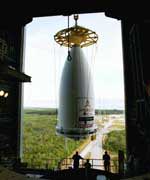As NASA’s Cassini spacecraft approached Saturn last July, it found evidence that lightning on Saturn is roughly one million times stronger than lightning on Earth.
That’s just one of several Cassini findings that University of Iowa Space Physicist Don Gurnett will present in a paper to be published Thursday, Dec. 16, in Science Express, an online version of the journal Science, and in a talk to be delivered Friday, Dec. 17, at a meeting of the American Geophysical Union in San Francisco.
Other findings include:
–Cassini impacted dust particles as it traversed Saturn’s rings.
–Saturn’s radio rotation rate varies.
The comparison between Saturn’s enormously strong lightning and Earth’s lightning began several years ago as the Cassini spacecraft prepared for its journey to Saturn by swinging past the Earth to receive a gravitational boost. At that time, Cassini started detecting radio signals from Earth’s lightning as far out as 89,200 kilometers from the Earth’s surface. In contrast, as Cassini approached Saturn, it started detecting radio signals from lightning about 161 million kilometers from the planet. “This means that radio signals from Saturn’s lightning are on the order of one million times stronger than Earth’s lightning. That’s just astonishing to me!” says Gurnett, who notes that some radio signals have been linked to storm systems observed by the Cassini imaging instrument.
Earth’s lightning is commonly detected on AM radios, a technique similar to that used by scientists monitoring signals from Cassini.
Regarding Saturn’s rings, Gurnett says that the Cassini Radio and Plasma Wave Science (RPWS) instrument detected large numbers of dust impacts on the spacecraft. Gurnett and his science team found that as Cassini approached the inbound ring plane crossing, the impact rate began to increase dramatically some two minutes before the ring plane crossing, then reached a peak of more than 1,000 per second at almost exactly the time of the ring plane crossing, and finally decreased to pre-existing levels about two minutes later. Gurnett notes that the particles are probably quite small, only a few microns in diameter, otherwise they would have damaged the spacecraft.
Finally, variations in Saturn’s radio rotation rate came as a surprise. Based upon more than one year of Cassini measurements, the rate is 10 hours 45 minutes and 45 seconds, plus or minus 36 seconds. That’s about six minutes longer than the value recorded by the Voyager 1 and 2 flybys of Saturn in 1980-81. Scientists use the rotation rate of radio emissions from the giant gas planets such as Saturn and Jupiter to determine the rotation rate of the planets themselves because the planets have no solid surfaces and are covered by clouds that make direct visual measurements impossible.
Gurnett suggests that the change in the radio rotation rate is difficult to explain. “Saturn is unique in that its magnetic axis is almost exactly aligned with its rotational axis. That means there is no rotationally induced wobble in the magnetic field, so there must be some secondary effect controlling the radio emission. We hope to nail that down during the next four to eight years of the Cassini mission.”
One possible scenario was suggested nearly 20 years ago. Writing in the May 1985 issue of “Geophysical Research Letters,” Alex J. Dessler, a senior research scientist at the Lunar and Planetary Laboratory, University of Arizona, argued that the magnetic fields of gaseous giant planets, such as Saturn and Jupiter, are more like that of the sun than of the Earth. The sun’s magnetic field does not rotate as a solid body. Instead, its rotation period varies with latitude. Commenting earlier this year on the work of Gurnett and his team, Dessler said, “This finding is very significant because it demonstrates that the idea of a rigidly rotating magnetic field is wrong. Saturn’s magnetic field has more in common with the sun than the Earth. The measurement can be interpreted as showing that the part of Saturn’s magnetic field that controls the radio emissions has moved to a higher latitude during the last two decades.”
The radio sounds of Saturn’s rotation — resembling a heartbeat — and other sounds of space can be heard by visiting Gurnett’s Web site at: http://www-pw.physics.uiowa.edu/space-audio
Cassini, carrying 12 scientific instruments, on June 30, 2004, became the first spacecraft to orbit Saturn and begin a four-year study of the planet, its rings and its 31 known moons. The $1.4 billion spacecraft is part of the $3.3 billion Cassini-Huygens Mission that includes the Huygens probe, a six-instrument European Space Agency probe, scheduled to land on Titan, Saturn’s largest moon, in January 2005.
The Cassini-Huygens mission is a cooperative project of NASA, the European Space Agency and the Italian Space Agency. JPL, a division of the California Institute of Technology, Pasadena, Calif. manages the Cassini-Huygens mission for NASA’s Office of Space Science, Washington, D.C. JPL designed, developed and assembled the Cassini orbiter. For the latest images and information about the Cassini-Huygens mission, visit: http://www.nasa.gov/cassini.
Original Source: UI News Release

